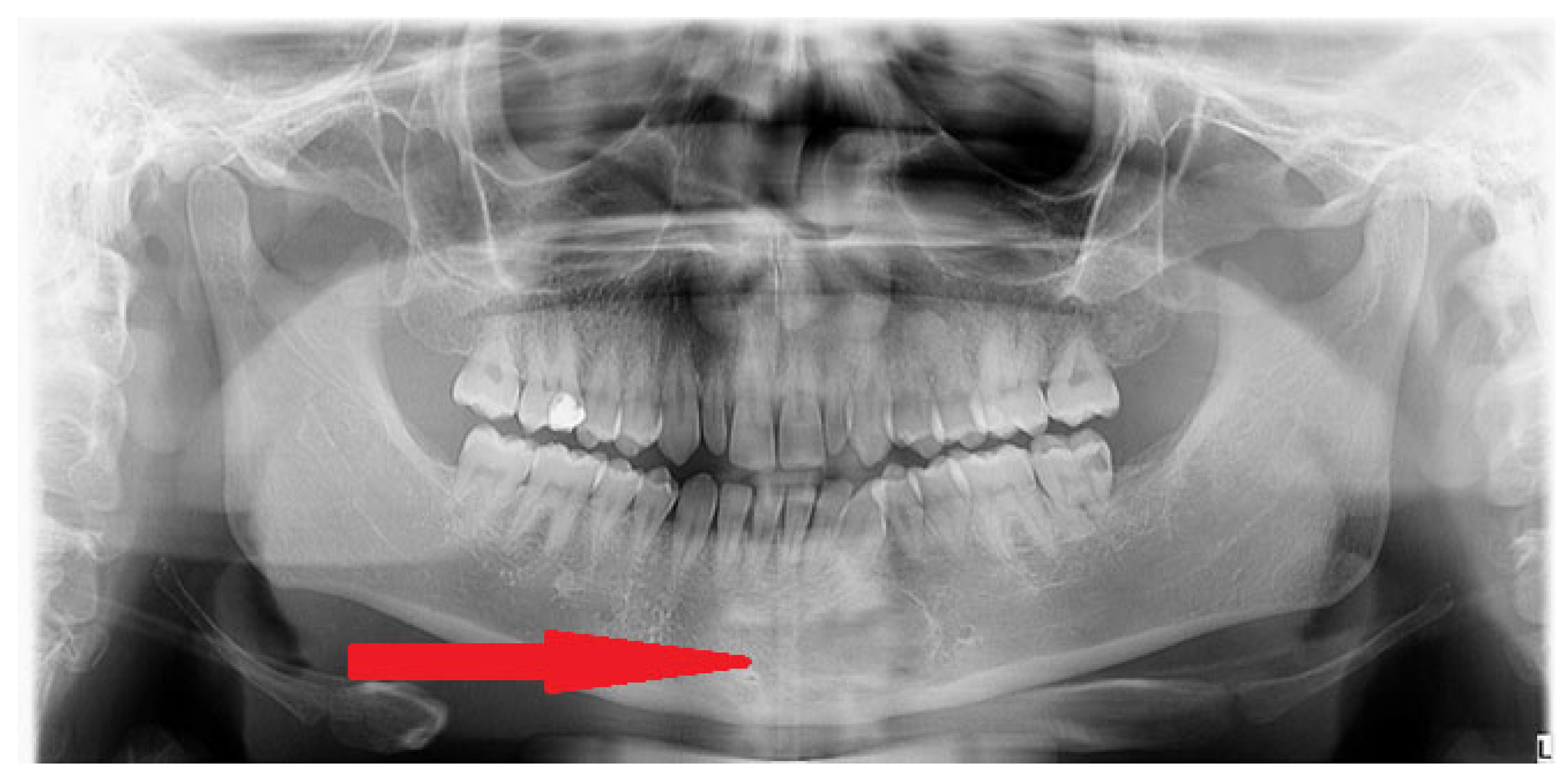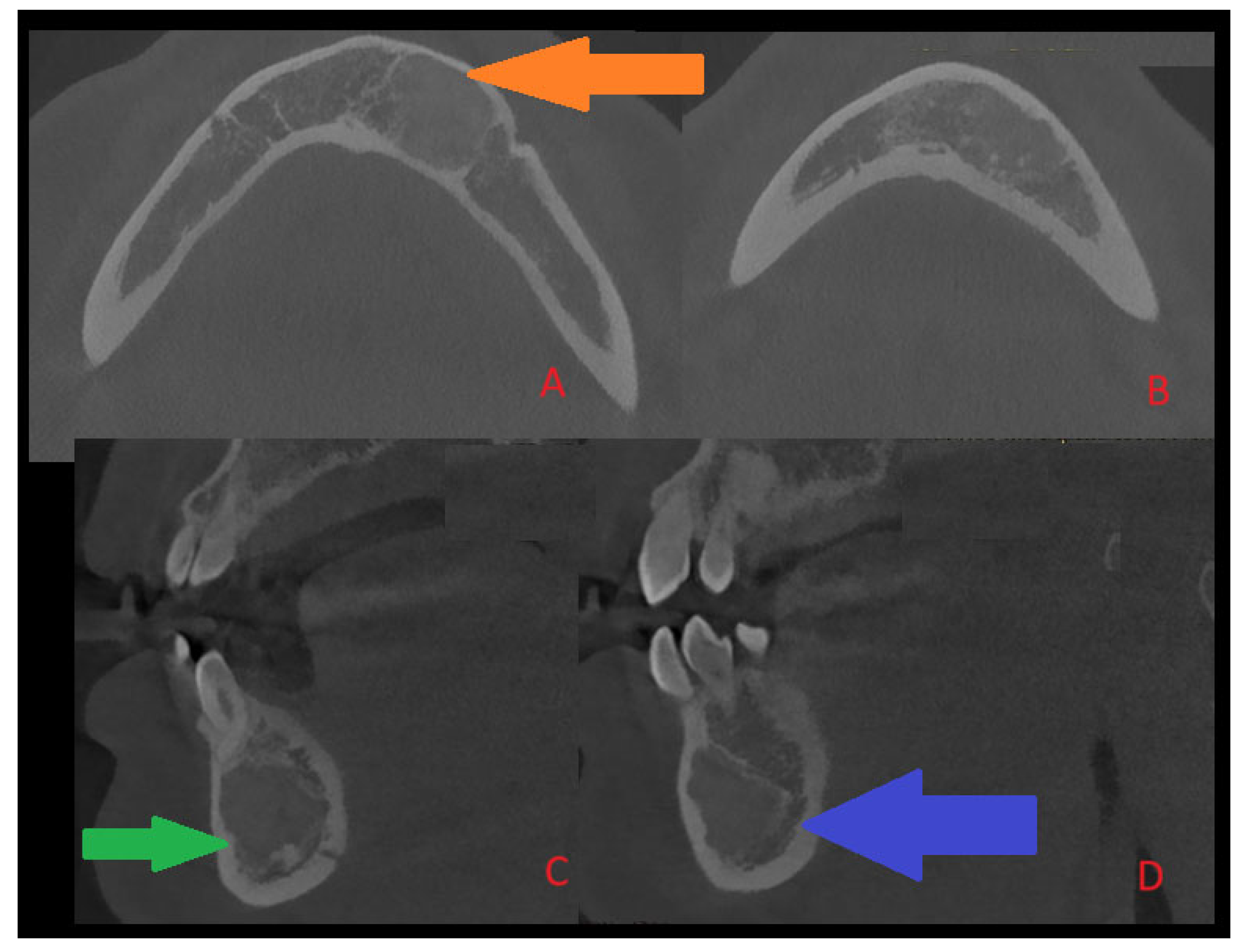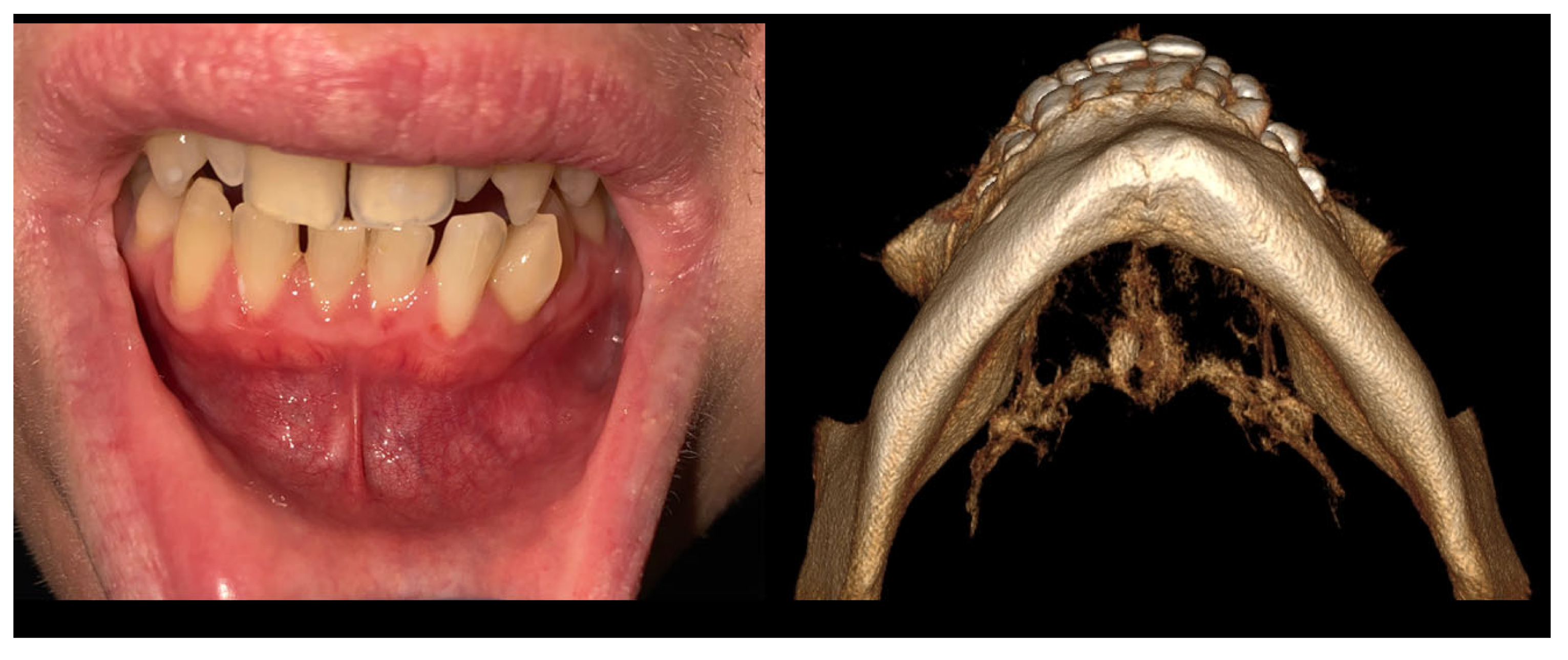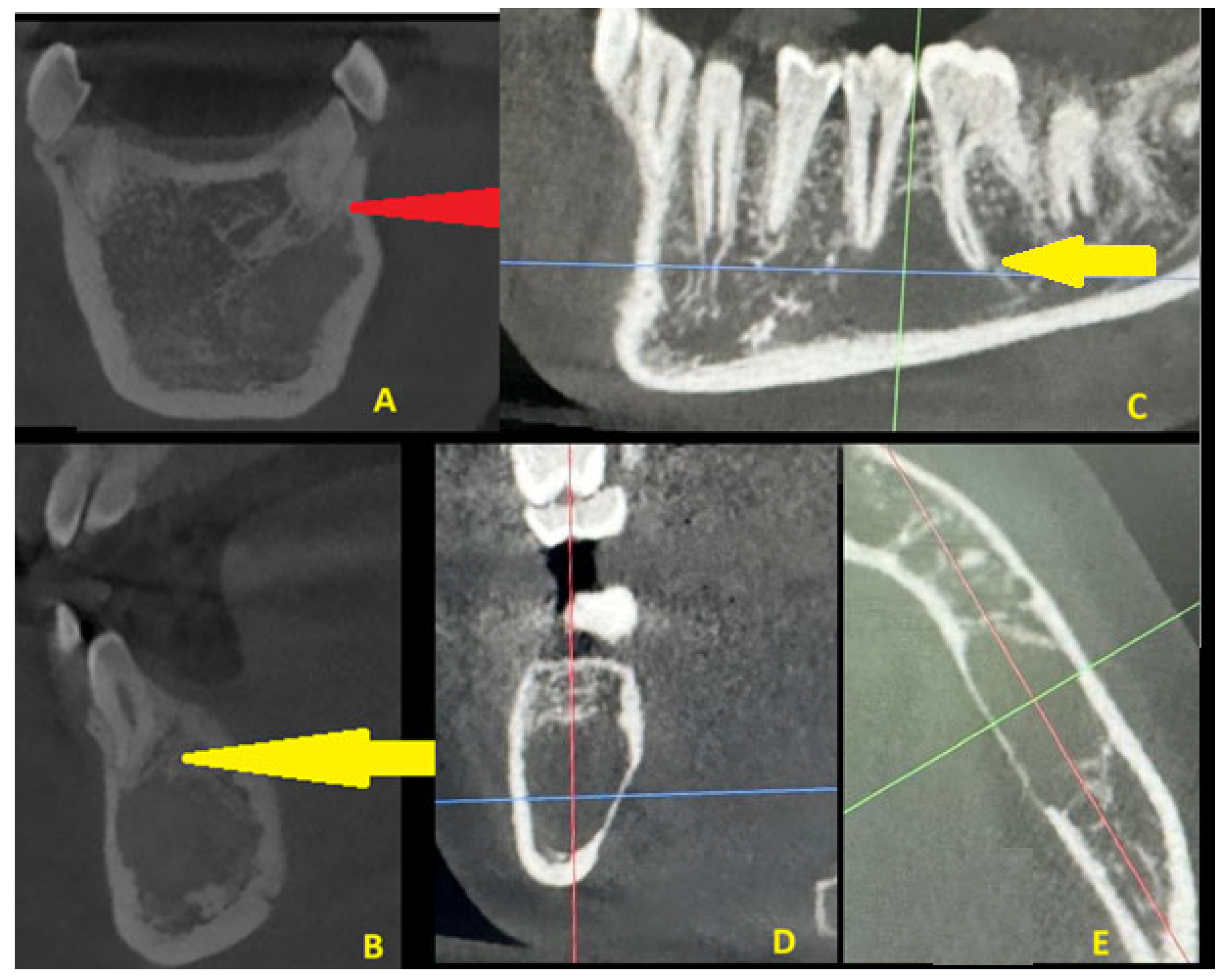A Cystic-like Lesion of Uncertain Origin—A Discussion on Cemento-Osseous Dysplasia and Traumatic Bone Cysts
Abstract





Author Contributions
Funding
Institutional Review Board Statement
Informed Consent Statement
Data Availability Statement
Conflicts of Interest
References
- Mishra, G.; Bernisha, R.; Bhogte, S.A.; Chitra, P. Idiopathic Osteosclerosis in Orthodontic Patients: A Report of Two Cases. Cureus 2024, 16, e53426. [Google Scholar] [CrossRef] [PubMed] [PubMed Central]
- Nelke, K.; Matys, J.; Janeczek, M.; Małyszek, A.; Łuczak, K.; Łukaszewski, M.; Frydrych, M.; Kulus, M.; Dąbrowski, P.; Nienartowicz, J.; et al. The Occurrence and Outcomes of Cemento-Osseous Dysplasias (COD) in the Jaw Bones of the Population of Lower Silesia, Poland. J. Clin. Med. 2024, 13, 6931. [Google Scholar] [CrossRef] [PubMed]
- Smołka, P.; Nelke, K.; Struzik, N.; Wiśniewska, K.; Kiryk, S.; Kensy, J.; Dobrzyński, W.; Kiryk, J.; Matys, J.; Dobrzyński, M. Discrepancies in Cephalometric Analysis Results between Orthodontists and Radiologists and Artificial Intelligence: A Systematic Review. Appl. Sci. 2024, 14, 4972. [Google Scholar] [CrossRef]
- Noffke, C.E.E.; Raubenheimer, E.J.; Peranovic, V. Cemento-osseous dysplasia: A diagnostic challenge. S. Afr. Dent. J. 2019, 74, 200–202. [Google Scholar]
- Park, S.; Jeon, S.J.; Yeom, H.G.; Seo, M.S. Differential diagnosis of cemento-osseous dysplasia and periapical cyst using texture analysis of CBCT. BMC Oral Health 2024, 24, 442. [Google Scholar] [CrossRef] [PubMed] [PubMed Central]
- Lis, E.; Gontarz, M.; Marecik, T.; Wyszyńska-Pawelec, G.; Bargiel, J. Residual Cyst Mimicking an Aggressive Neoplasm—A Life-Threatening Condition. Oral 2024, 4, 354–361. [Google Scholar] [CrossRef]
- Gumru, B.; Akkitap, M.P.; Deveci, S.; Idman, E. A retrospective cone beam computed tomography analysis of cemento-osseous dysplasia. J. Dent. Sci. 2021, 16, 1154–1161. [Google Scholar] [CrossRef] [PubMed] [PubMed Central]
- Urs, A.B.; Augustine, J.; Gupta, S. Cemento-osseous dysplasia: Clinicopathological spectrum of 10 cases analyzed in a tertiary dental institute. J. Oral Maxillofac. Pathol. 2020, 24, 576. [Google Scholar] [CrossRef] [PubMed] [PubMed Central]
- Decolibus, K.; Shahrabi-Farahani, S.; Brar, A.; Rasner, S.D.; Aguirre, S.E.; Owosho, A.A. Cemento-Osseous Dysplasia of the Jaw: Demographic and Clinical Analysis of 191 New Cases. Dent. J. 2023, 11, 138. [Google Scholar] [CrossRef] [PubMed] [PubMed Central]
- Brody, A.; Zalatnai, A.; Csomo, K.; Belik, A.; Dobo-Nagy, C. Difficulties in the diagnosis of periapical translucencies and in the classification of cemento-osseous dysplasia. BMC Oral Health 2019, 19, 139. [Google Scholar] [CrossRef] [PubMed] [PubMed Central]
Disclaimer/Publisher’s Note: The statements, opinions and data contained in all publications are solely those of the individual author(s) and contributor(s) and not of MDPI and/or the editor(s). MDPI and/or the editor(s) disclaim responsibility for any injury to people or property resulting from any ideas, methods, instructions or products referred to in the content. |
© 2025 by the authors. Licensee MDPI, Basel, Switzerland. This article is an open access article distributed under the terms and conditions of the Creative Commons Attribution (CC BY) license (https://creativecommons.org/licenses/by/4.0/).
Share and Cite
Nelke, K.; Karpiński, M.; Scharoch, M.; Janeczek, M.; Małyszek, A.; Kalfarentzos, E.; Mavrakos, E.; Kuropka, P.; Perisanidis, C.; Dobrzyński, M. A Cystic-like Lesion of Uncertain Origin—A Discussion on Cemento-Osseous Dysplasia and Traumatic Bone Cysts. Diagnostics 2025, 15, 2312. https://doi.org/10.3390/diagnostics15182312
Nelke K, Karpiński M, Scharoch M, Janeczek M, Małyszek A, Kalfarentzos E, Mavrakos E, Kuropka P, Perisanidis C, Dobrzyński M. A Cystic-like Lesion of Uncertain Origin—A Discussion on Cemento-Osseous Dysplasia and Traumatic Bone Cysts. Diagnostics. 2025; 15(18):2312. https://doi.org/10.3390/diagnostics15182312
Chicago/Turabian StyleNelke, Kamil, Maciej Karpiński, Michał Scharoch, Maciej Janeczek, Agata Małyszek, Evagelos Kalfarentzos, Efthymios Mavrakos, Piotr Kuropka, Christos Perisanidis, and Maciej Dobrzyński. 2025. "A Cystic-like Lesion of Uncertain Origin—A Discussion on Cemento-Osseous Dysplasia and Traumatic Bone Cysts" Diagnostics 15, no. 18: 2312. https://doi.org/10.3390/diagnostics15182312
APA StyleNelke, K., Karpiński, M., Scharoch, M., Janeczek, M., Małyszek, A., Kalfarentzos, E., Mavrakos, E., Kuropka, P., Perisanidis, C., & Dobrzyński, M. (2025). A Cystic-like Lesion of Uncertain Origin—A Discussion on Cemento-Osseous Dysplasia and Traumatic Bone Cysts. Diagnostics, 15(18), 2312. https://doi.org/10.3390/diagnostics15182312









